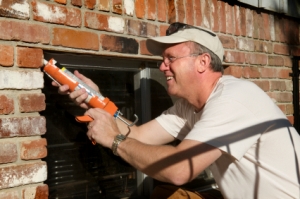Oct 22 2013
With winter around the corner some homeowners may be thinking about plugging all the leaks in their home to make them less drafty. Imagine if every homeowner in the country did that—how much energy could be saved? Using physics-based modeling of the U.S. housing stock, researchers from Lawrence Berkeley National Laboratory (Berkeley Lab) found in a new study that upgrading airtightness to a uniform level could achieve as much as $33 billion in annual energy savings.

“Currently people who weatherize can get their homes about 20 to 30 percent tighter. But they’re not sealing all the cracks. There’s still quite a bit left on the table, and those extra leaks and cracks could potentially save a lot of energy,” said Berkeley Lab scientist Jennifer Logue, lead author of the study, “Energy impacts of envelope tightening and mechanical ventilation for the U.S. residential sector,” which was recently published online in the journal Energy and Buildings. Her co-authors were Berkeley Lab scientists Max Sherman, Iain Walker and Brett Singer.
Logue said the purpose of their study was to figure how much energy is wasted from leaky homes and determine the optimal standard of airtightness—one that would maximize energy savings while minimizing the cost of achieving those savings. This is an important question because the residential sector—113 million homes—uses about 23 percent of total U.S. source energy annually. (Source energy includes site energy, the energy consumed by buildings for heating and electricity, as well as the raw energy required to transmit, deliver and produce it.) Heating and cooling accounts for about half of the site energy used in residences.
The largest potential savings are in the hottest and coldest climates. As new air enters homes through leaks and cracks, it has to be cooled or heated. Although the trend has been towards building tighter houses, Logue says the science is still not settled on the best ways to minimize leaks. “More research is needed to figure out what are the most effective ways to weatherize,” she said. “There are still benefits to be gained if we can figure out how to weatherize more effectively.”
The Berkeley Lab researchers considered five levels of tightening: “average” tightening, “advanced” tightening, the International Energy Conservation Code (IECC) standard, the R2000 standard (common in Canada, tighter than IECC) and the “passive house” standard, the tightest and most difficult to achieve.
They found that upgrading all homes to be as airtight as the top 10 percent of similar homes (advanced tightening) would decrease energy demand by 2.6 quads annually—out of the total 22 quads of source energy used by the residential housing sector—leading to roughly $22 billion in savings in energy bills. Reaching the IECC standard would yield savings of 3.83 quads in annual source energy, yielding $33 billion in savings.
The study found that the IECC standard offered most of the benefit that the tighter standards would yield. Moreover this standard is likely more achievable than the tighter standards. According to their analysis, raising the U.S. housing stock to the IECC standard would reduce airflow in homes by a median value of 50 percent.
“As we move forward and look to build better housing stock, we want to know what standards we should enforce,” Logue said. “It looks like the IECC standard gets us the majority of the benefit of air sealing. More research is needed to determine the costs of implementing each of these standards in new homes to see which are cost-effective. As we get better at air sealing, we can move towards tighter envelopes in buildings. ”
The analysis in the study factored in the energy costs of increasing ventilation where necessary to maintain good indoor air quality. A separate analysis looked at the energy cost of only bringing the housing stock into compliance with ASHRAE 62.2, a national ventilation standard for homes that ensures sufficient ventilation for human health.
“We found that the energy burden would be pretty small, only about an additional 0.2 quads of source energy annually”—less than 0.1 percent of total source energy that goes to the residential housing sector—“to get everyone to the level where they’re getting enough whole-house ventilation,” Logue said.
Funding for this study came from the Department of Energy, the Department of Housing and Urban Development and the California Energy Commission.